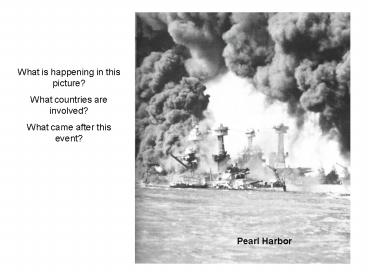Pearl Harbor - PowerPoint PPT Presentation
1 / 12
Title:
Pearl Harbor
Description:
What is happening in this picture? What countries are involved? What came after this event? Pearl Harbor Internment Camps Executive Order 9066 President Franklin D ... – PowerPoint PPT presentation
Number of Views:128
Avg rating:3.0/5.0
Title: Pearl Harbor
1
What is happening in this picture? What
countries are involved? What came after this
event?
Pearl Harbor
2
Internment Camps Executive Order 9066
President Franklin D Roosevelt authorized the
internment with Executive Order 9066, which
allowed local military commanders to designate
"military areas" as "exclusion zones", from which
"any or all persons may be excluded." This power
was used to declare that all people of Japanese
ancestry were excluded from the entire Pacific
coast, including all of California and most of
Oregon and Washington, except for those in
internment camps.
3
(No Transcript)
4
Name State Opened Max. Pop'n
Manzanar California March 1942 10,046
Tule Lake California May 1942 18,789
Poston Arizona May 1942 17,814
Gila River Arizona July 1942 13,348
Granada Colorado August 1942 7,318
Heart Mountain Wyoming August 1942 10,767
Minidoka Idaho August 1942 9,397
Topaz Utah September 1942 8,130
Rohwer Arkansas September 1942 8,475
Jerome Arkansas October 1942 8,497
5
WCCAWestern Civilian Control Administration WRAW
ar Relocation Authority
6
(No Transcript)
7
(No Transcript)
8
Two Camps in Arizona
Poston was built on the Colorado River Indian
Reservation, over the objections of the Tribal
Council, who refused to be a part of doing to
others what had been done to their tribe.
However, officials of the Bureau of Indian
Affairs overrode the Council, seeing the
opportunity to bring in improvements and develop
agricultural land, on the War Department budget
and with thousands of "volunteers," which would
remain after the war and aid the Reservation's
permanent population.
Gila River War Relocation Center It was located
about 80 km (50 miles) southeast of Phoeniz
Arizona The relocation center was located on the
Gila River Indian Reservation, near an irrigated
agricultural center. It comprised two separate
camps, named 'Canal' and 'Butte'. Construction
began on May 1 1942, over the strong objections
of the reservation's American Indian government.
Canal Camp closed on September 28, 1945 Butte
Camp was shut down on November 10, 1945. Some of
the intended internees died enroute to Gila River
or shortly after arrival in the harsh desert
environment
9
Describe the political Cartoon, What is the
first image your eyes sees, was the cartoon done
by a American or Japanese, What feelings do you
get from the cartoon, is the author mad, happy
angry?
10
(No Transcript)
11
Korematsu v. United States
Fred Korematsu was a U.S.-born Japanese American
man who decided to stay in San Leandro California
and knowingly violate Civilian Exclusion Order
No. 34 of the U.S. Army, because he refused to be
separated from his non-Japanese, Italian-American
girlfriend. He was arrested and convicted. No
question was raised as to Korematsu's loyalty to
the United States. The Circuit Court of Appeals
affirmed the conviction, and the Supreme Court
In a 6-3 decision, the Court sided with the
government, ruling that the exclusion order
leading to Japanese American Internment was not
unconstitutional. The opinion, written by Supreme
Court justice Hugo Black held that the need to
protect against espionage outweighed Fred
Korematsus individual rights, and the rights of
Americans of Japanese descent.
12
The decision in Korematsu v. United States has
been very controversial. Indeed, Korematsu's
conviction for evading internment was overturned
on November 10, 1983.
Did the President and Congress go beyond their
war powers by implementing exclusion and
restricting the rights of Americans of Japanese
descent?






























